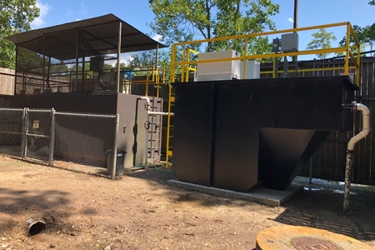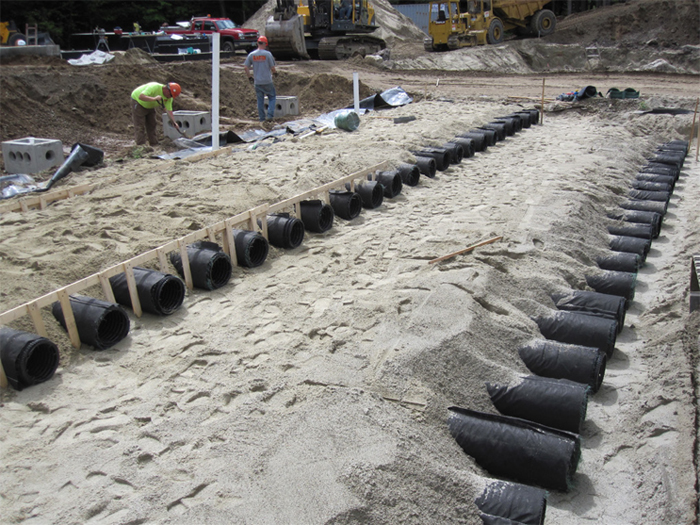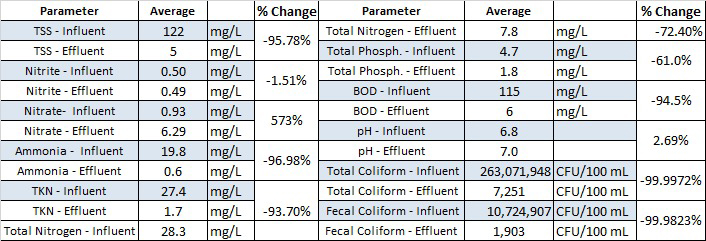Community Wastewater Treatment Options Expand With Decentralized Treatment Approaches
By Dennis F. Hallahan

Sometimes conventional wastewater treatment solutions won’t work for a given application, and sometimes a nonconventional approach is simply the better choice for high-quality, cost-effective performance.
For wastewater treatment engineers, designers, and community decision-makers, selecting the most effective technology and design to meet treatment needs, existing and impending regulations, capacity for future expansion, and cost effectiveness can be challenging. The wide variety of new technologies and innovative system designs has increased performance and reduced maintenance. These innovations can also utilize or repurpose existing infrastructure and lower overall construction and operating costs.
For municipalities, capital expenditures for upgrades to publicly owned treatment works are highly scrutinized. This level of oversight and the limited resources available to cities and towns for infrastructure upgrades may create an atmosphere that limits consideration of the available cost-effective, high-performance options. The good news for communities interested in sustainable development is that new codes are catalyzing the development of an expanding number of approaches for upgrading residential onsite systems or expanding an existing centralized treatment facility.
A broad search for the best available wastewater treatment option can net a solution that better matches the unique conditions of the individual project and the community and create a climate for desirable development. While opting for traditional wastewater treatment solutions might be the comfort zone, alternative and advanced technologies frequently offer better performance and greater versatility in challenging environments or when under financial constraints. Most alternative wastewater treatment systems have long, successful performance records and provide third-party treatment testing and certifications that consistently show superior and reliable treatment capabilities.
Large Commercial And Industrial Systems
In some cases, towns and municipalities have centralized wastewater treatment plants (WWTP) that are overburdened and cannot support community growth. In such cases, large decentralized systems can be designed to handle new, large-flow commercial and industrial development, thereby decreasing the hydraulic and nutrient stress placed on centralized WWTPs and augmenting the capacity to sustain community growth. In the case of community wastewater treatment facilities that are reaching or over capacity, adding an exfiltration bed utilizing subsurface infiltration, such as an engineered chamber drainfield system, can extend the life and community investment in the WWTP and have the added benefit of reducing phosphorus and eliminating outfall discharges to bodies of water.
The Best Solution May Be A Combination Of Approaches
In many instances, utilizing a combination of approaches is the best solution for large commercial systems or communities. These system designs often provide decentralized collection that moves to a centralized treatment facility, then to a large disposal field. Most publicly and privately owned community systems are, similar to centralized systems, centrally managed by professional operators.
Top-Line Considerations
Anticipated flows, available land, financial considerations, and special community characteristics that need to be retained are top-line considerations requiring analysis by wastewater design engineers and the communities or projects they represent. The timeline for municipal treatment upgrades is also important to consider in relation to the viability of desirable new development. It’s key to review all of the available technology and design options, including traditional approaches and alternative, advanced solutions based on anticipated wastewater flows, existing systems, and regulatory environment challenges.
Wastewater Design Strategies For Sustainable Development
There are many approaches to sustainable wastewater design. The following are a few options that provide excellent treatment and versatility to address challenging wastewater treatment needs.
STEP Systems
Communities without public sewer systems or adequate onsite septic systems to employ decentralized strategies can tie into an existing neighboring centralized WWTP with the installation of septic tank effluent pump (STEP) systems to upgrade individual onsite treatment systems. A STEP system incorporates individual tanks to collect wastewater that is then sent to a centralized treatment plant.
Cluster Systems
Where centralized wastewater treatment facilities are overburdened and the addition of new sewer lines is prohibited, or where individual septic systems are frowned upon, cluster systems are being recommended to developers by local health departments and planning agencies. Cluster systems collect the wastewater from individual or groups of dwellings or businesses and transfer that wastewater to a centralized drainfield for treatment.
Advanced Onsite Wastewater Treatment Systems (AOWTS)
AOWTS provide high-level treatment strategies and system designs that address nitrogen reduction, watershed protection, and sensitive environments. Wastewater engineers find these preengineered systems easily adaptable to a variety of site conditions and particularly beneficial in coastal or watershed communities where dispersal to surface waters is no longer an option or polluting discharges endanger watersheds. AOWTS provide long-term treatment solutions that can be designed in multiple small-scale or single large system applications.
Membrane Bioreactors (MBRs)
MBRs employ suspended growth for treatment and clarification via semipermeable membrane material. The membranes have pores created during the manufacturing process that are very small and uniform in size. The membrane module or cassette is submerged directly in the suspended aeration process. The effluent moves from outside the membranes to inside under a minimal vacuum that pulls the permeate into the void area inside the membrane and out of the system for discharge.
Professional Management
Recognizing the need to advocate advanced wastewater treatment systems on a scale that will support positive development, wastewater and municipal engineers also recognize and often require these systems to be professionally managed. Professional management provides more control on the quality of the waste treatment process. Some utilities are favoring this approach as the most cost-effective, long-term solution.

Pipe bundles in the double-stacked configuration are properly spaced.
Applications In Action
Innovative Upgrade Of New Hampshire Community’s Municipal Wastewater Treatment Plant Incorporates Recirculation For Denitrification
Originally designed in 1959 as a seasonal wastewater treatment facility (WWTF) for a lakeside community in Newbury, NH, the 50,000-GPD Blodgett Landing WWTF was not equipped to meet the treatment requirements of the 21st century. As the population grew and residences were converted to year-round use, effluent testing and groundwater monitoring confirmed nitrate concentrations were a growing problem.
Following a successful pilot study to explore collecting a portion of the treated effluent to recirculate through the sludge layer of the existing 34,000-gallon Imhoff tank to facilitate denitrification, plans were made to incorporate denitrification into the planned upgrade to the treatment plant. Project engineers at Presby Environmental, Inc. (PEI) recommended incorporating the Enviro-Septic technology into the existing sand filter configuration to enhance aerobic nitrification and allow increased denitrification in the recirculation process. The passive treatment performance of the technology utilizes the naturally occurring bacterial process, eliminating the need for added chemicals, biological additives, or electrical energy. Its subsurface configuration and low maintenance requirements are desirable for any community. For Newbury, this innovative approach allowed the rehabilitation and continued use of the existing Imhoff tank and sand filter/rapid infiltration basins (RIBs), resulting in construction cost savings.
The upgraded Blodgett Landing WWTF has been operating for over eight years with very consistent results. The Blodgett Landing Facility has experienced significant reductions in certain wastewater contaminants, including fecal coliform, total nitrogen (TN), five-day biochemical oxygen demand (BOD5), and total suspended solids (TSS).

Ongoing Average Performance of the Blodgett Landing Municipal Wastewater Treatment Facility from January 2012 to November 2020
New Package Sewage Treatment Plant Replaces One In Service For More Than 35 Years At Louisiana Community Park
Pelican Park in Mandeville, LA, is a 550-acre community park with 32 athletic fields, two gyms, and a 46,000-square-foot multipurpose community center. The community park also includes an 18-hole disc golf course and parking for more than 1,700 vehicles. Nearly 35 years ago, the community installed a 3,000-GPD package sewage treatment plant to serve the park’s operations at that time. With the tank nearing the end of its expected lifecycle due to rust resulting from outdated prep and coating methods, the park’s staff knew they needed a new replacement system.
Because the park was happy with the existing system and its longevity, they contracted Delta to fabricate a new extended aeration package plant replacement system that would be easy for the team to use due to familiarity with the previous model. Package sewage treatment plants are custom designed to the particular sewage treatment needs of each location and are suitable for permanent or temporary use in areas beyond the reach of municipal wastewater systems. The package treatment plant is shipped to the project site as a self-contained unit that requires minimal assembly.
The new system at Pelican Park effectively handles the more than 12,000 park visitors each Saturday and 1 million visitors per year. The early 2021 installation and start-up went smoothly.
Conclusion
Municipalities, states, and the federal government have tough decisions to make in addressing wastewater treatment needs and the funds required for infrastructure improvements. New approaches and products provide increasingly better performing, cost-effective alternatives to traditional centralized sewering and old onsite septic system technologies. In many cases, where centralized wastewater infrastructure is not in place or where it is over capacity and no funds are available to undertake new infrastructure projects, taking alternative and/or advanced treatment approaches into consideration is necessary to sustain development and to protect waterways, groundwater supplies, public health, and the environment.
About The Author
 Dennis F. Hallahan, PE, has more than 30 years of experience with onsite wastewater treatment systems design and construction. Currently Technical Director at Infiltrator Water Technologies, he is responsible for technology transfer between Infiltrator and the regulatory and design communities and consults on product research and testing for universities and private consultants. Hallahan received his MS in civil engineering from the University of Connecticut and his BS in civil engineering from the University of Vermont. He is a registered professional engineer in Connecticut and holds several patents for onsite wastewater products.
Dennis F. Hallahan, PE, has more than 30 years of experience with onsite wastewater treatment systems design and construction. Currently Technical Director at Infiltrator Water Technologies, he is responsible for technology transfer between Infiltrator and the regulatory and design communities and consults on product research and testing for universities and private consultants. Hallahan received his MS in civil engineering from the University of Connecticut and his BS in civil engineering from the University of Vermont. He is a registered professional engineer in Connecticut and holds several patents for onsite wastewater products.
